Throughout my time playing Magic, I’ve always thought that combo decks should be linear. Maximum redundancy was always the motto. If the combo was good
enough, you wanted to increase your chances of drawing it by playing card selection spells like Ponder, Brainstorm, and the like. If your combo wasn’t good
enough, then you should be playing something else.
Or so I thought.
Over the last year, I’ve had some success in Modern with multiple variations of Splinter Twin, and none of the versions used the motto. These Splinter Twin
decks weren’t all-in on the combo because they couldn’t be. There was too much disruption, so we needed an alternate plan of attack. Common spells
like Abrupt Decay and Thoughtseize coupled with various hate cards out of the sideboard changed the game, not to mention the banning of all the best card
selection. Without access to Ponder or Preordain in Modern, having the combo on Turn 4 or 5 with protection was no longer feasible. We needed an alternate
plan of attack, and Tarmogoyf was the chosen weapon.
And then came Khans of Tarkir, which threw a wrench into everything I knew about Modern. Treasure Cruise and Dig Through Time made it impossible to win
games when you went the other route. The fair route. It wasn’t all that difficult to gain control of a game in Modern with a few removal spells and
counterspells, but what happens when your plan of attrition gets thrown out the window with a single card? But those decks also had a ton of disruption,
making it virtually impossible for Splinter Twin to exist in a world where U/R Delver was a deck.
But with the banning of Treasure Cruise, Dig Through Time, and Birthing Pod with the release of Fate Reforged, things were once again unclear to me. B/G/x
decks threatened to dominate the format without Birthing Pod to keep them in check. Lingering Souls combined with the efficiency of Abrupt Decay and
discard spells made it difficult for any deck to gain traction, which bottlenecked the format into becoming something muddled and non-interactive. Why try
to interact with a deck that is the king of interaction? Lingering Souls and Tarmogoyf are only as good as you make them.
Before the Pro Tour, I was under the assumption that the Splinter Twin combo was not very good. I had played multiple tournaments leading up to the Pro
Tour where I did not combo a single opponent, instead relying on Tarmogoyf to do most of the dirty work. I was alright with this plan, but it did not feel
great against the B/G/x decks. Abrupt Decay was targeting Tarmogoyf too regularly, and Lingering Souls bricked your Pestermites and Vendilion Cliques.
Siege Rhino also helped them regain lost life and tempo, and it was almost always bigger than my Tarmogoyfs.
So for the Pro Tour, I left my Tarmogoyfs behind in favor of Modern’s newest bad boy.
Who ended up as a necklace for Dragonlord Silumgar…
Creatures (14)
- 2 Grim Lavamancer
- 3 Pestermite
- 1 Vendilion Clique
- 1 Deceiver Exarch
- 4 Snapcaster Mage
- 3 Tasigur, the Golden Fang
Lands (22)
Spells (24)

I went 7-3 with my take on Tasigur Twin, a Grixis version very similar to the Temur Twin decks I worked on with Tarmogoyf. But something about the deck
felt a little off, and it took me a while to figure out exactly what it was. Against some decks, all you want to do is combo kill them with Splinter Twin.
Some call this the “fun police,” but I call it the “bull**** check.” You need to be able to beat the random decks in Modern, which generally means having a
ton of disruption or an explosive finish to your deck. This is one of the reasons why Birthing Pod was so good for so long; it could do it all. It could
easily grind you out in a fair game of Magic, but it could also assemble a few different infinite combos. This invalidated many archetypes from both sides
of the spectrum. But it also had access to some of the best disruption in the format.
The newest iterations of Splinter Twin are trying to do the same things as Birthing Pod. We can win long, fair games (though it isn’t easy), we can win the
combo games, and we can apply heavy disruption to our opponent. But Splinter Twin isn’t as strong as Birthing Pod was at either disruption or the long
game, but it is much better at winning with its combo. A reasonable trade-off but much worse in a world where everyone knows how to attack Splinter Twin.
So why does Splinter Twin keep doing well if people know how to attack it? Well, there are quite a lot of answers to that question, but it is unreasonable
to assume that Splinter Twin pilots don’t know what’s going to be thrown at them. There is a reason nearly every Splinter Twin deck has a secondary
gameplan. These usually include Batterskull, Keranos, Thrun, or some other combination of powerful sideboard bombs. Relying solely on the combo after Game
1 against most decks is foolish, because they will have almost all the answers necessary to prevent you from combo killing them. And therein lies
the power of Splinter Twin.
Fear.
The fear of losing on Turn 4 is terrifying. And that fear is what Splinter Twin preys on. They will not tap out if they have Abrupt Decay in hand. That
leaves them with multiple mana each turn left on the table. That leaves them sitting on their hands, afraid to cast their creatures and actually put
pressure on you. Yes, your creature will eventually die to that removal spell, but you can constantly put your mana to use on either turn since most of
your spells have flash or are instants. The players with the best results against me tend to have a much more cavalier attitude about how they play the
matchup. They will usually give me a window or two to combo them out of the game, but if I don’t have it right then and there, then the odds of me winning
decrease significantly. Tapping out never looked so good.
The fact that most Splinter Twin decks have the capability of siding out their entire combo is gross for multiple reasons. Against fair decks, their
ability to interact with your combo puts you in an awkward position. Thoughtseize can leave you with multiple copies of Splinter Twin stranded in your
hand. Removal spells like Abrupt Decay can keep you from comboing off, even if you have a counterspell for protection. And that isn’t even taking into
consideration the sideboard cards like Torpor Orb, which can be a nightmare.
But when you have the ability to side out your entire combo, you invalidate so many cards that your opponents could be bringing in. This is the other side
of Splinter Twin that people don’t get to see too much because most people who playtest only play Game 1, and their only sideboarded games come at
tournaments. You can have a great Game 1 against Splinter Twin, but pre- and post-boarded games are significantly different animals, and that is something
a lot of people don’t realize. I gain a huge advantage in Modern tournaments because I understand how the matchups are supposed to play out at every point
in a match, not just in Game 1s. I also have a great grasp in how to fight against the plans that most people have, but that isn’t an attribute that comes
naturally. It takes a lot of time and mental energy to figure that kind of stuff out, let alone hundreds or thousands of games.
So what’s the best version of Splinter Twin? Well, we’ll hopefully answer that question today, but Splinter Twin is incredibly customizable. I tend to
change the third color regularly and significantly alter my plans based on other popular decks. In a combo-heavy metagame, the U/R Splinter Twin deck is
great. For starters, I would suggest Seth Manfield’s U/R Splinter Twin deck from the Open Series in Baltimore.
Creatures (13)
Lands (23)
Spells (24)

This list is based off Dan Lanthier’s list from Grand Prix Vancouver a few weeks before, but I much prefer the fourth Snapcaster Mage if I’m being honest.
Minor differences aside, the U/R Splinter Twin deck (that splashes for Ancient Grudge) is a phenomenal force in Modern. It can occasionally burn out the
opponent with some timely Lightning Bolts, Snapcaster Mages, and Grim Lavamancers, all while pinging the opponent’s life total with Pestermite, Deceiver
Exarch, and Vendilion Clique. Games will often be won or lost by a few points of life, making sequencing your turns correctly invaluable.
But this list is also best for beating all the random decks that can crop up in Modern. The Splinter Twin combo is efficient, doesn’t bog your deck down
with too many useless combo pieces, and interacts in a positive way with opposing combo decks by tapping their lands before they have a chances to use
them. You have a lot of breathing room against aggressive decks with Grim Lavamancer and a slew of removal spells, and your manabase doesn’t deal you as
much damage as either Temur Twin or Tasigur Twin.
This is the least unique version, though it’s probably the most consistent. It doesn’t get too cute or too creative, but it does have multiple angles of
attack. It has access to potent sideboard weapons to help fight long games, as Batterskull and Keranos are tough for fair decks to interact with. Sower of
Temptation is also a great card against any Abrupt Decay deck for obvious reasons. If you are just getting on board with Splinter Twin, I would highly
recommend starting here.
But if you want to play a bit more of a tempo game and expect the field to be full of other Splinter Twin and aggressive decks, might I suggest Tarmogoyf?
Creatures (15)
Lands (22)
Spells (23)

Here’s the list I played at that same tournament, falling to Seth Manfield after stumbling on mana two games in a row. One thing people don’t realize about
the Splinter Twin mirror, no matter which version you’re playing, is that the person with access to the most mana each turn will normally win. If both
players have the same amount of mana, then it comes down to who draws the best or plays the best. There are so many small, intricate decisions to be made,
and something as minor as using a fetchland on your own main phase can matter (thanks to Vendilion Clique).
I think that an early Tarmogoyf can give you a serious leg-up in the mirror matches. It allows you to put pressure on your opponent without much effort and
can be incredibly difficult to kill. Putting pressure on your opponent also makes Remand a significantly better spell. If you’re forcing them to play
spells when you want them to, then Remand will have serious implications on the game as opposed to just cycling and putting their Pestermite back in their
hand. Any sort of early pressure is great in the mirror, even if you are only presenting the illusion of pressure. Grim Lavamancer dies to every removal
spell in the deck and looks awkward against Electrolyze, but it can also be a way for you to combo kill their Deceiver Exarch with Lightning Bolt.
But Tarmogoyf is vulnerable to both Abrupt Decay and Spell Snare, two cards seeing a lot of play in Modern. It also doesn’t do much in the lategame other
than attack and block, and a Tarmogoyf off the top of the deck in the lategame doesn’t mean all that much when you’re significantly behind. I liked
Tarmogoyf a lot more when Abrupt Decay was on the decline, so my goal for the last few weeks has been to find the line between the two. I want consistency,
but I also want to be able to pressure my opponents when it is convenient. I want to maximize the combo in Game 1, but I want to be able to side into a
tempo deck against any non-combo deck.
Introducing the best of both worlds:
Creatures (13)
Lands (23)
Spells (24)

If you look closely, the maindeck is very similar to the normal U/R Splinter Twin decks. We have a lot of combo pieces, a bit of disruption, removal, and a
few alternate methods of attack. We can win games on the back of our combo or a few Lightning Bolts and Snapcaster Mages. But instead of having a light
splash of green for Ancient Grudge, we are moving into a whole new genre with the sideboard.
The one thing I really disliked about the Splinter Twin sideboards was how expensive Batterskull and Keranos were. Sure, you want an alternate gameplan
against highly disruptive decks, and those cards are great at doing that, but you also don’t want to be constantly tapping out. You want to keep the fear
in them, and you also want a huge threat against the mirror that doesn’t require completely tapping out. Most people leave in some remnants of the combo,
making your tap-out turns significantly worse if you have the potential to just die on the spot.
Enter Tasigur, the Golden Fang (again).
The worst part about Tasigur is that his ability is only as good as the cards in your deck. If you’re rolling over extra copies of Deceiver Exarch or
Splinter Twin, then his ability is pretty terrible, and I want all of my cards to function smoothly in a deck like this. What good is an extra card if that
extra card is bad? When you give your opponent options, you want those options to be bad for them. That’s one of the reasons why my Pro Tour deck had fewer
copies of the Splinter Twin combo, as I wanted to be more reliant on Tasigur just beating them down.
But as the format has fleshed itself out, I want to be pretty heavy on the combo in Game 1. That means building the deck like the U/R version. I still want
access to Terminate, as the card is phenomenal in a number of matchups, but I also want access to a threat out of the sideboard that can hammer my opponent
for having too many hate cards out of the sideboard. Tasigur can do that efficiently and effectively.
I replaced most of the more expensive sideboard cards with Tasigur because I wanted a leg up on the mirrors. When they’re trying to do things that are
incredibly expensive, Remand is invaluable. Remand can also be good against Tasigur, but you can also play him for a wide variety of casting costs, usually
leaving up Spell Snare, Remand, or Dispel to protect it. You rarely have that same luxury with either Batterskull or Keranos.
The thing I like most about Tasigur out of the sideboard is that your deck will always be configured perfectly for each matchup, making his ability
spectacular at nearly every juncture. The fact that you can use Grim Lavamancer to pick and choose what you leave in your graveyard is great, though there
is a bit of stress between the two. Having an early Grim Lavamancer and a Tasigur in your hand usually means you’re stuck between picking one or the other,
unless you’re able to draw a Thought Scour or a ton of cheap spells and fetchlands. Usually you can just get your beatdown on with Grim Lavamancer until
you get both into play, but your Grim Lavamancer will almost always be good once the game gets going. Using the Tasigur ability to fuel the graveyard with
Grim Lavamancer is also pretty sweet.
The basic theory behind this deck is that Tasigur is a phenomenal card in Modern and should be put to good use. However, we also need ways to counteract
what our opponents are doing. Having a heavy emphasis on the Splinter Twin combo gives us some breathing room against the random other combo decks in the
format, but playing black instead of green gives us access to a lot of great sideboard options. This deck is incredibly flexible, and it will give your
opponent a lot of headaches when trying to figure out how to sideboard appropriately.
With Tasigur in the deck over Tarmogoyf, we’re also making our opponent’s removal spells worse. Tasigur has the ability to go long, gaining card advantage
while also supplying you with some early pressure to gain leverage. Abrupt Decay was always good against Splinter Twin, so why make it better by playing
Tarmogoyf as your alternate sideboard plan? If we take out our combo pieces against B/G/x decks, then Tarmogoyf becomes their only real target for Abrupt
Decay. But when we have Tasigur, the only real target is Snapcaster Mage and Vendilion Clique, two creatures who can gain a significant amount of value
before dying to their removal spell.
Lingering Souls can still be a problem for this version of the deck, but you do have ways to fight it. Izzet Staticaster has been unreal, and even
Engineered Explosives is fine against B/G/x decks. There will be times when Engineered Explosives killing their Tarmogoyfs will be the only thing that
saves you, but there will be other times where they flood the board with tokens, only to have them die to one of your sweet sideboard cards. Izzet
Staticaster also has some alternate value, giving you a different creature to sacrifice to Liliana at instant speed, or helping your Grim Lavamancers and
Lightning Bolts trade up with their bigger threats. But Izzet Staticaster is just ridiculous in two other popular matchups: Affinity and Infect.
While this version of Splinter Twin can still have its problems, I think it is one of the best versions I’ve been able to create for some time. I’m excited
to try it out in a real tournament, but it has been fantastic so far on Magic Online. I’ve used every sideboard card in a variety of matchups, and they all
feel like they’ve earned their keep. Having the fluidity to move between tempo and combo when it is appropriate is vexing for many opponents, as they are
never really sure what you’re going to throw at them.
But this isn’t the end of the line for Splinter Twin. Every single tournament can give us a reason to try something different. Always keep an open mind
when building these kinds of decks in Modern, as a single sideboard slot could be the difference in losing a match and winning the tournament. I keep
finding that trying new things in Modern can easily lead to success, as the format is so large and diverse. There is a lot of room to explore!
With the Dragons of Tarkir Prerelease coming this weekend, I am excited to try a few new cards in Modern. Here’s the short list:
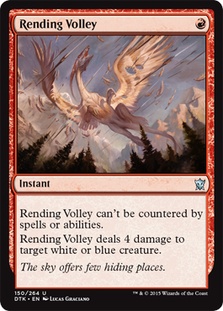
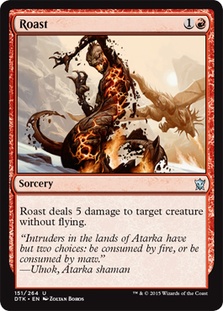
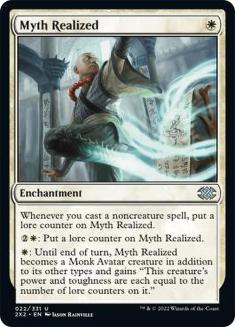
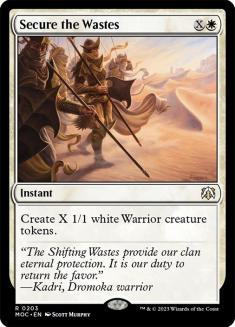
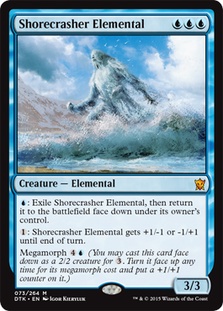
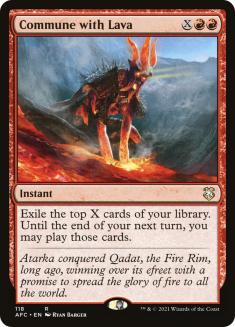
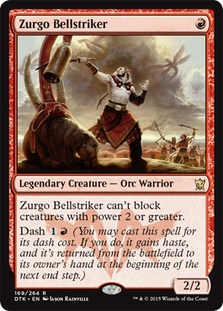
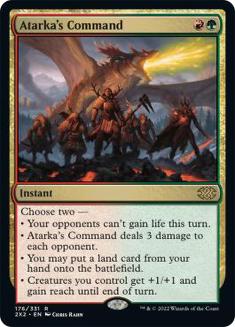
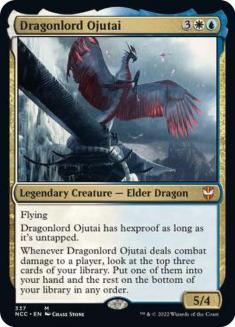
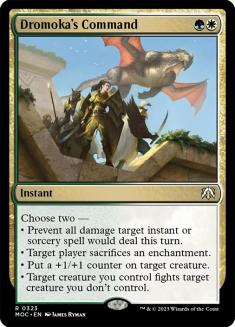
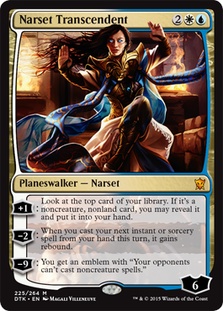
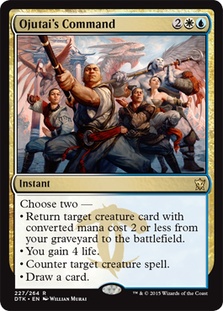
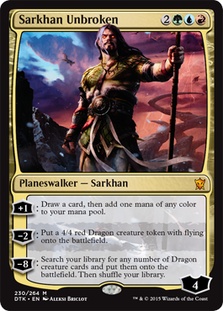

While I’m not sure if all of these (or any, for that matter) will make a significant impact on Modern, there are a lot of support cards to help out
existing archetypes. Specifically, Rending Volley is almost a strict upgrade to Combust, but I think Roast will help out a lot of red decks in killing
Tarmogoyf. The others require a bit more thinking, but I’m sure many of them will end up seeing play eventually.
While none of these cards seem to threaten Modern like Treasure Cruise or Dig Through Time, I am glad to see they are not afraid to print cards that could
see play in older formats. Modern is alive and well, and I hope it stays that way for some time to come.


